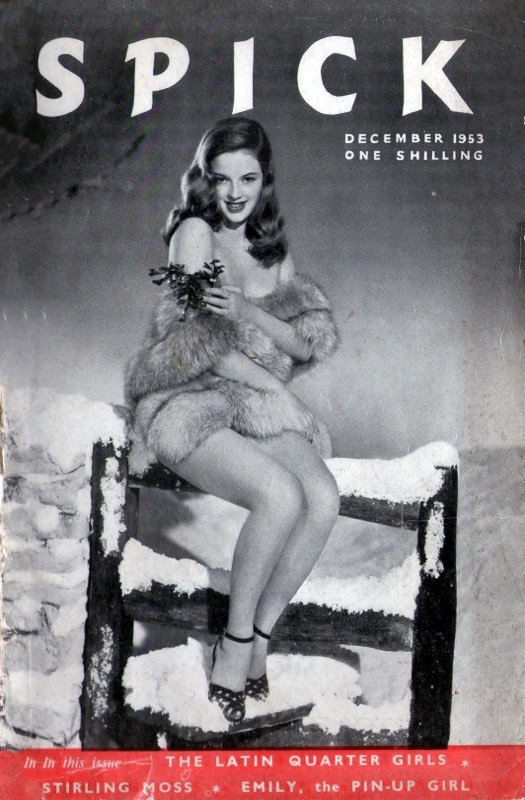Spick 1953 – 1976 (276 issues plus 15 extras)
First issue December 1953, last issue November 1976. (Spick Data PDF)
Spick was the first of the trio and first published in December 1953, as Britain was beginning to emerge from post-war austerity.
The cover of the first issue featured the then very popular pin-up girl Diana Dors and the masthead proclaimed the mag to be about “Life and action, people and pictures”. This first edition that started the ball rolling is very interesting – it contains 48 photos but only two are of girls wearing stockings; there are more photos of racing cars than nylons. And the model Emily, whose surname is never given in any of her appearances, starts off with a typical ToCo sequence of a girl in the countryside getting into trouble with skirt up and legs in the air – but after the first two photos, she has taken off her stockings and suspender belt. Even stocking tops, an otherwise daily sight in those days, seemed to be pushing the ToCo limit of sensibility and, for some editions, were actually retouched. Or perhaps they were included as an exploratory expedition to see what reader reaction would be. Certainly that sequence became the essence of all the titles for the next quarter of a century.
Spick 2 saw the introduction of a feature that came to stay – readers’ letters. It illustrates well how the image and mission of the mag changed. There was a letter from a Miss C.T. Carstairs complaining that “Spick has entirely neglected its potential feminine readership” and that she would only continue to buy it “if you include features of more appeal to women. So there.” It seems extraordinary now, but it does show how quickly perception changed. Also in that first collection of letters was the first, but far from the last, letter from a soldier – possibly National Service − requesting more pictures of Emily to brighten up the barracks. The abolition of National Service in the early 1960s was probably the greatest financial disaster in ToCo’s nearly 25 years of publishing. Just to emphasise the difference in character even more, that edition also included a debate on whether America was truly a democracy and an article about Arsenal football club!
Further to the above observation about the lack of stockings in the earlier editions of Spick, another reader’s letter (Spick 77 April 1960) bemoaned the situation – “”a pretty girl’s leg is much more attractive in nylons […] and black ones for preference”. ToCo seems to have been responsive to positive criticism; in the first edition of Spick, only 5% of the photos featured stockings, by the time of this letter 50%, and by the final edition 70%.
In the early days, the girls were mostly professional models, but there was always a section for amateurs, and readers were encouraged to send in photographs of their wives and girlfriends. After a year or so, readers were urging the editor to replace the photos of “over-glamorised film stars” with more of the Beautiful Britons pages and “more of girls like Pat Arnold, Lamorna Lea and Rosa Domaille”. A female – yes female − reader was moved to write a letter published in Span 45 in May 1958 saying, “ Don’t you think Spick and Span would be even more popular if you increased your features on the pretty girls who work in factories and office and concentrated less on showgirls? As a housewife and mother of two attractive daughters … I’m sure the ordinary working girls retain their charm while showgirls lose a lot of theirs.” This demand heralded the evolution of two new magazines – 66 (containing 66 photos of a single model, usually a film star) and Beautiful Britons (devoted exclusively to amateur or semi-pro models).
And another reader, not happy with the short stories that were a feature of the early Spicks, complained “I’m not for beefcake, battleships [from an article about the American war of independence] or Beautiful Britain [the two photos of British countryside]. All I want is that you should devote 90% of your pages to cheesecake.” So gradually, the homely atmosphere of badly-composed, but immensely popular, pictures with 1950s-style furnishings as backdrops began to dominate the magazine. Perhaps the attraction was a touch of voyeurism at catching girls apparently unawares in their own homes.
They were known as ‘pocket size’ publications, being just under seven inches by five inches, or approximately A5 size. A larger size was introduced in 1970 in an attempt to compete with other popular men’s magazines of the time like Parade, but it was so unfavourably received by collectors that, after just three issues, the ‘pocket size’ returned, and remained until cessation of publication.
Another reader’s letter (Spick 6, April 1954), requests fortnightly publication – and this only six months after the beginning of publication. The editor’s reply in Spick 8 was that ToCo intended to publish a new magazine – Span − between the Spicks. The publishers must have been ecstatic. Span 1 duly arrived on 6 September.
They were published on the 20th of the preceding month but dated for the next month, with the 15 quarterly Extras appearing on the 30 March, June, September and December from 1958 to 1960.
